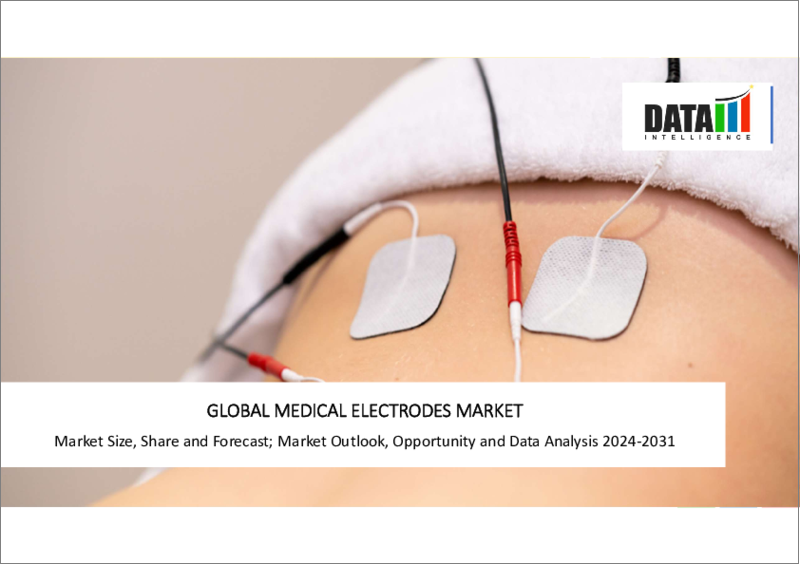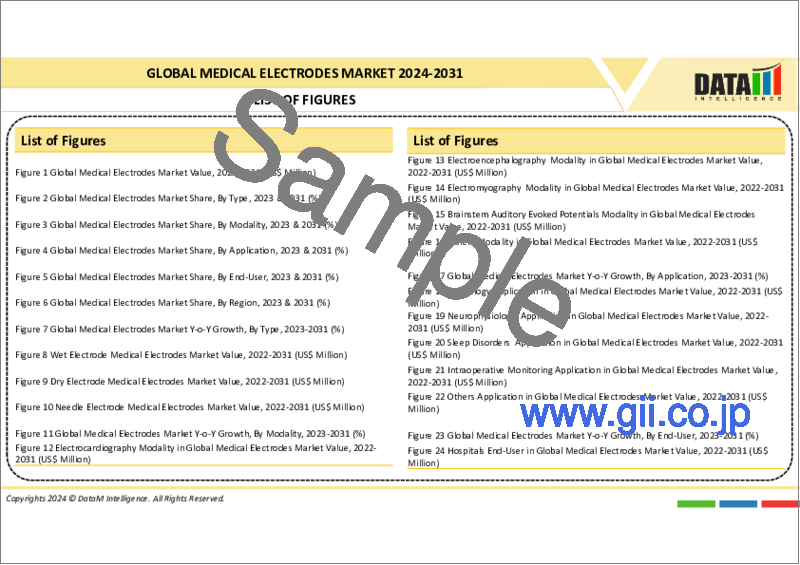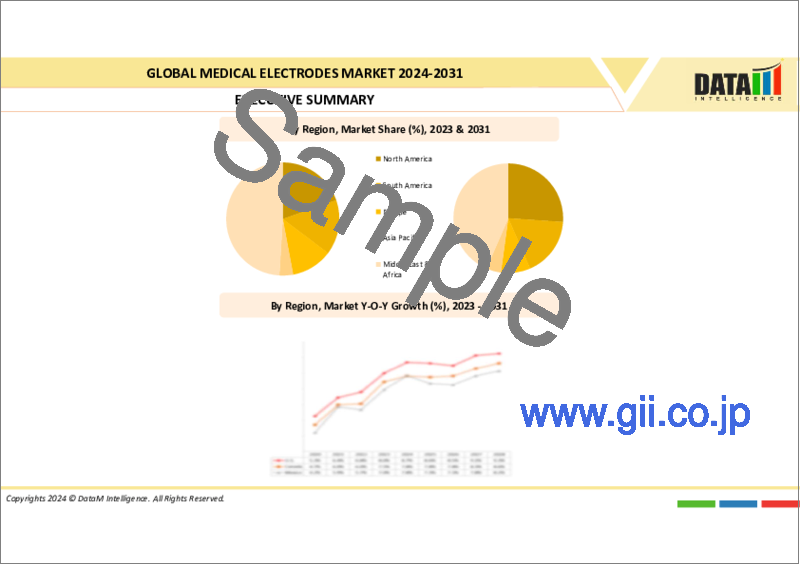|
|
市場調査レポート
商品コード
1336716
医療用電極の世界市場-2023年~2030年Global Medical Electrodes Market - 2023-2030 |
||||||
カスタマイズ可能
適宜更新あり
|
|||||||
| 医療用電極の世界市場-2023年~2030年 |
|
出版日: 2023年08月22日
発行: DataM Intelligence
ページ情報: 英文 195 Pages
納期: 即日から翌営業日
|
- 全表示
- 概要
- 目次
市場概要
医療用電極の世界市場は、2022年に9億米ドルに達し、2023-2030年の予測期間にCAGR 4.1%で成長し、2030年には12億米ドルに達すると予測されています。
医療用電極は、内部イオン電流の表面測定を可能にし、その結果、通常はその存在を確認するために外科的介入を必要とするいくつかの神経学的、筋肉学的、眼科的、心臓学的、および他の病気に対する非侵襲的診断をもたらします。電極は多くの場合、使い方が簡単で、使い捨てが可能(または容易に滅菌可能)であり、多くの場合、補助する活動に特徴があります。電極の主な機能は、患者と、活動の測定や記録に使用される機器との間の最適な電気的接触を維持することです。
さらに、世界の医療用電極市場は、心血管疾患や神経疾患の増加、技術の進歩、低侵襲手術の増加、医療費の増加、疾患の早期発見と管理に関する意識の高まりなど、様々な要因によって牽引されています。
市場力学
心血管疾患の有病率の上昇
心血管疾患の有病率の上昇は、医療用電極市場が予測期間中に成長するための重要な主要因の1つです。このような疾患に関連する高い死亡リスクにより、患者の頻繁な医療診断の割合が増加しています。例えば、米国疾病予防管理センター(Centers for Disease Control and Prevention)が更新したファクトシートによると、米国では40秒ごとに805,000人が心臓発作を経験しており、そのうち605,000人が初発例、200,000人がすでに経験した人です。心臓発作の約5回に1回は無症状で、本人が気づかないうちに障害を引き起こしています。
技術の進歩
医療用電極は心電図(ECG)モニタリング装置で心臓疾患の診断によく使用されます。心電図は心血管系疾患の診断に最も広く利用されており、検査技術は今日の技術ニーズに合わせて向上しています。標準的な心臓ホルターやイベントレコーダーとは対照的に、革命的な技術を組み込んだ装置は、はるかにコスト効率が高く、ユーザーフレンドリーです。
さらに、電極の小型化と電極ケーブルの廃止により、配線が絡まることなく患者の胸部に装着できるようになっています。分析期間中、医療機器におけるこのような技術開拓は市場成長をかなり促進しました。
例えば、2022年10月5日、カーネギーメロン大学の研究者は、ブレイン・コンピュータ・インターフェイス・プラットフォーム用の微小電極アレイであるCMU Arrayを開発しました。このソリューションは、医師が様々な神経疾患を治療する方法を変えると期待されています。このような技術革新は、医療用電極市場の採用を後押しすると思われます。
厳しい政府規制
厳しい政府規制は、予測期間中の市場成長を妨げる要因の一つです。厳しい政府規制は、製品の安全性、品質、有効性を保証するため、医療用電極市場では非常に重要です。これらの規制は、高水準の維持、技術革新の促進、患者の福利の保護に役立っています。このような要件を遵守することはメーカーにとって重要であり、医療用電極の全体的な信頼性を確保するのに役立ちます。
さらに、一部の新興国や低開発国では、関連する技術的ブレークスルーやこのようなデバイスの利点に関する知識不足が、予測期間中のこの市場の成長を阻害する可能性があります。
目次
第1章 調査手法と調査範囲
第2章 定義と概要
第3章 エグゼクティブサマリー
第4章 市場力学
- 影響要因
- 促進要因
- 心血管疾患の有病率の上昇
- 技術の進歩
- 抑制要因
- 厳しい政府規制
- 機会
- 低侵襲手術への注目の高まり
- 影響分析
- 促進要因
第5章 産業分析
- ポーターのファイブフォース分析
- サプライチェーン分析
- 価格分析
- 規制分析
第6章 COVID-19分析
第7章 製品タイプ別
- 診断用電極
- 治療用電極
第8章 タイプ別
- 湿式電極
- 乾式電極
- ニードル電極
第9章 用途別
- 循環器
- 神経生理学
- 睡眠障害
- 術中モニタリング
- その他
第10章 エンドユーザー別
- 病院
- 診断センター
- その他
第11章 地域別
- 北米
- 米国
- カナダ
- メキシコ
- 欧州
- ドイツ
- 英国
- フランス
- スペイン
- イタリア
- その他欧州
- 南米
- ブラジル
- アルゼンチン
- その他南米
- アジア太平洋
- 中国
- インド
- 日本
- オーストラリア
- その他アジア太平洋
- 中東・アフリカ
第12章 競合情勢
- 競合シナリオ
- 市況/シェア分析
- M&A分析
第13章 企業プロファイル
- Medtronic
- 会社概要
- 製品ポートフォリオと説明
- 財務概要
- 主な動向
- Koninklijke Philips N.V.
- Ambu
- Natus Medical Incorporated
- 3M
- CONMED Corporation
- Rhythmlink International, LLC
- Leonhard Lang GmbH
- Nihon Kohden Corporation
- Compumedics
第14章 付録
Market Overview
Global Medical Electrodes Market reached US$ 0.9 billion in 2022 and is expected to reach US$ 1.2 billion by 2030 growing with a CAGR of 4.1% during the forecast period 2023-2030.
Medical electrodes enable the surface measurement of internal ionic currents, resulting in a non-invasive diagnostic for several neurological, muscular, ophthalmic, cardiac, and other illnesses that would normally require surgical intervention to confirm their presence. The electrodes are often simple to use, disposable (or readily sterilizable), and often distinctive in the activities they assist with. The electrode's primary function is to maintain optimal electrical contact between the patient and the instrument used to measure or record activity.
Furthermore, the global medical electrodes market is driven by various factors like rising cardiovascular and neurological diseases, technological advancements, a rise in minimally invasive surgeries, increasing healthcare spending, and rising awareness about early disease detection and management.
Market Dynamics
Rise in the Prevalence of Cardiovascular Diseases
The rise in the prevalence of cardiovascular diseases is one of the significant key factors that helps the medical electrodes market to grow during the forecast period, owing to the high mortality risk associated with such disorders has increased the rate of frequent medical diagnosis of patients. For instance, according to the Centers for Disease Control and Prevention updated factsheet in the US, 805,000 people experience a heart attack every 40 seconds, with 605,000 being first-time cases and 200,000 being those who have already experienced one. About 1 in 5 heart attacks are silent, causing damage without the person being aware.
Rise in Technological Advancements
Medical electrodes are often used in electrocardiogram (ECG) monitoring systems to diagnose heart problems. ECG has been the most widely utilised type of diagnostics for cardiovascular diseases, and testing techniques are improving to match today's technological needs. The revolutionary technology-incorporated devices, as opposed to standard cardiac holter and event recorders, are far more cost-effective and user-friendly.
Furthermore, with the miniaturisation of electrodes and the elimination of electrode cables, devices may now be installed on the patient's chest without a tangle of wires. During the analysis period, such technical developments in medical devices considerably enhanced market growth.
For instance, on 5th October 2022, researchers at Carnegie Mellon University developed the CMU Array - a microelectrode array for brain-computer interface platforms. The solution is expected to transform the way doctors treat various neurological ailments. Such innovations will bolster the medical electrodes market adoption.
Stringent Government Regulations
Stringent government regulations are one of the restraints that hamper market growth during the forecast period. As stringent government regulations are critical in the medical electrodes market because they ensure product safety, quality, and efficacy. These regulations aid in the maintenance of high standards, the promotion of innovation, and the protection of patient well-being. Compliance with such requirements is critical for manufacturers and helps to ensure the overall reliability of medical electrodes.
Furthermore, a lack of knowledge about the associated technical breakthroughs and advantages of such devices in some emerging or underdeveloped countries may impede the growth of this market during the forecast period.
Segment Analysis
The global medical electrodes market is segmented based on product type, type, application, end-user and region.
The Diagnostic Medical Electrodes From the Product Segment Accounted for Approximately 41.7% of the Medical Electrodes Share
The diagnostic medical electrodes from the product segment with around 41.7% is expected to dominate during the forecast period owing to recent launches by key players, technological advancements will drive the segment growth. For instance, in November 2022, Brain Scientific a Florida-based medical device technology company, announced the immediate release of the improved and updated NeuroCap device and the signing of a distribution partnership with D&D Medical, Inc., to sell the company's neurology devices in Tennessee, Kentucky, Indiana, and West Virginia.
Brain Scientific developed the NeuroCap to streamline EEG prep, testing and diagnosis. NeuroCap has 22 pre-gelled electrodes making it a suitable option for most clinical EEG tests, including routine EEGs that are often used for stroke and epilepsy patients. The fixed electrode placement is in accordance with the international 10-20 system.
Geographical Penetration
North America Accounted for Approximately 38.4% of the Market Share in 2022
North America is estimated to hold about 38.4% of the total market share throughout the forecast period, due to its superior healthcare infrastructure, new launches, effective government policies, vast multinational company base, and a high level of awareness about testing and testing devices in healthcare. This region also witnesses a high prevalence of chronic inflammatory disorders, such as cardiovascular diseases, diabetes, inflammatory bowel disease (IBD), and cancer, compared to other chronic indications.
Increasing expenditure on healthcare and rising awareness among people, advancement of technologies for treatment, and increase in biopharmaceutical establishment across the region are also contributing to the growth of medical electrodes share of this region.
For instance, in May 2023 NeuroOne Medical Technologies Corporation, a medtech company focused on improving surgical care options and outcomes for patients suffering from neurological disorders, announced the commercial launch of the Evo sEEG electrode product line in the United States.
Competitive Landscape
The major global players in the medical electrodes market include Medtronic, Koninklijke Philips N.V., Ambu, Natus Medical Incorporated, 3M, CONMED Corporation, Rhythmlink International, LLC, Leonhard Lang GmbH, Nihon Kohden Corporation, Compumedics and among others
COVID-19 Impact Analysis
Segmentation
By Product Type
- Diagnostic Medical Electrodes
Electrocardiography
Electroencephalogram
Electromyography
- Therapeutic Medical Electrodes
Defibrillator
Transcutaneous Electrical Nerve Stimulation electrodes
Electrosurgical Electrodes
Neuromuscular and Muscular Electrical Stimulation (NMES)
Pacemaker electrodes
By Type
- Wet Electrodes
- Dry Electrodes
- Needle Electrodes
By Application
- Cardiac
- Neurophysiology
- Sleep Disorders
- Intraoperative Monitoring
- Others
By End User
- Hospitals
- Diagnostic Centers
- Others
By Region
- North America
U.S.
Canada
Mexico
- Europe
Germany
U.K.
France
Spain
Italy
Rest of Europe
- South America
Brazil
Argentina
Rest of South America
- Asia-Pacific
China
India
Japan
Australia
Rest of Asia-Pacific
- Middle East and Africa
Key Developments
- In December 2022 NeuroOne Medical Technologies Corporation fulfilled a commercial order for sEEG electrodes and shipped them to Zimmer Biomet, as per their agreement. This development marks a significant milestone for the company and its efforts to expand its market presence.
- In November 2022, EMOTIV Partnered with X-trodes to launched New Medical-Grade, At-Home Solution for Brain Monitoring Research. X-trodes' wearable sensing technology is partnered with EmotivPRO, a neuroscience data platform, to enhance sleep studies and kinesiology research. The proprietary dry-printed electrodes stream user-generated data through the EmotivPRO mobile app, allowing processing and analysis on the cloud-based platform.
- In October 2022 Nihon Kohden launched a new product called the Smart Cable NMT Pod and disposable electrode. This device allows clinicians to objectively monitor the depth of paralysis in patients during surgery when a neuromuscular blockade agent (NMBA) is administered, whether non-depolarizing or depolarizing. With this innovation, clinicians can confidently monitor neuromuscular blockade, improving patient outcomes and enhancing surgical procedures.
Why Purchase the Report?
- To visualize the global medical electrodes market segmentation based on product type, type, application, end user and region as well as understand key commercial assets and players.
- Identify commercial opportunities by analyzing trends and co-development.
- Excel data sheet with numerous data points of medical electrodes market level with all segments.
- PDF report consists of a comprehensive analysis after exhaustive qualitative interviews and an in-depth study.
- Product mapping available as excel consisting of key products of all the major players.
The global medical electrodes report would provide approximately 53 tables, 54 figures and 195 pages.
Target Audience 2023
- Manufacturers/ Buyers
- Industry Investors/Investment Bankers
- Research Professionals
- Emerging Companies
Table of Contents
1. Methodology and Scope
- 1.1. Research Methodology
- 1.2. Research Objective and Scope of the Report
2. Definition and Overview
3. Executive Summary
- 3.1. Snippet by Product Type
- 3.2. Snippet by Type
- 3.3. Snippet by Application
- 3.4. Snippet by End User
- 3.5. Snippet by Region
4. Dynamics
- 4.1. Impacting Factors
- 4.1.1. Drivers
- 4.1.1.1. Rise in the Prevalence of Cardiovascular Diseases
- 4.1.1.2. Rise in Technological Advancements
- 4.1.2. Restraints
- 4.1.2.1. Stringent Government Regulations
- 4.1.3. Opportunity
- 4.1.3.1. Rising Focus toward Minimally Invasive Surgeries
- 4.1.4. Impact Analysis
- 4.1.1. Drivers
5. Industry Analysis
- 5.1. Porter's 5 Forces Analysis
- 5.2. Supply Chain Analysis
- 5.3. Pricing Analysis
- 5.4. Regulatory Analysis
6. COVID-19 Analysis
- 6.1. Analysis of COVID-19
- 6.1.1. Scenario Before COVID-19
- 6.1.2. Scenario During COVID-19
- 6.1.3. Scenario Post Covid-19
- 6.2. Pricing Dynamics Amid COVID-19
- 6.3. Demand-Supply Spectrum
- 6.4. Government Initiatives Related to the Market During Pandemic
- 6.5. Manufacturers Strategic Initiatives
- 6.6. Conclusion
7. By Product Type
- 7.1. Introduction
- 7.1.1. Market Size Analysis and Y-o-Y Growth Analysis (%), By Product Type
- 7.1.2. Market Attractiveness Index, By Product Type
- 7.2. Diagnostic Medical Electrodes *
- 7.2.1. Introduction
- 7.2.2. Market Size Analysis and Y-o-Y Growth Analysis (%)
- 7.3. Therapeutic Medical Electrodes
8. By Type
- 8.1. Introduction
- 8.1.1. Market Size Analysis and Y-o-Y Growth Analysis (%), By Type
- 8.1.2. Market Attractiveness Index, By Type
- 8.2. Wet Electrodes *
- 8.2.1. Introduction
- 8.2.2. Market Size Analysis and Y-o-Y Growth Analysis (%)
- 8.3. Dry Electrodes
- 8.4. Needle Electrodes
9. By Application
- 9.1. Introduction
- 9.1.1. Market Size Analysis and Y-o-Y Growth Analysis (%), By Product Application
- 9.1.2. Market Attractiveness Index, By Product Application
- 9.2. Cardiology *
- 9.2.1. Introduction
- 9.2.2. Market Size Analysis and Y-o-Y Growth Analysis (%)
- 9.3. Neurophysiology
- 9.4. Sleep Disorders
- 9.5. Intraoperative Monitoring
- 9.6. Others
10. By End User
- 10.1. Introduction
- 10.1.1. Market Size Analysis and Y-o-Y Growth Analysis (%), By End User
- 10.1.2. Market Attractiveness Index, By End User
- 10.2. Hospitals *
- 10.2.1. Introduction
- 10.2.2. Market Size Analysis and Y-o-Y Growth Analysis (%)
- 10.3. Diagnostic Centers
- 10.4. Others
11. By Region
- 11.1. Introduction
- 11.1.1. Market Size Analysis and Y-o-Y Growth Analysis (%), By Region
- 11.1.2. Market Attractiveness Index, By Region
- 11.2. North America
- 11.2.1. Introduction
- 11.2.2. Key Region-Specific Dynamics
- 11.2.3. Market Size Analysis and Y-o-Y Growth Analysis (%), By Product Type
- 11.2.4. Market Size Analysis and Y-o-Y Growth Analysis (%), By Type
- 11.2.5. Market Size Analysis and Y-o-Y Growth Analysis (%), By Application
- 11.2.6. Market Size Analysis and Y-o-Y Growth Analysis (%), By End User
- 11.2.7. Market Size Analysis and Y-o-Y Growth Analysis (%), By Country
- 11.2.7.1. U.S.
- 11.2.7.2. Canada
- 11.2.7.3. Mexico
- 11.3. Europe
- 11.3.1. Introduction
- 11.3.2. Key Region-Specific Dynamics
- 11.3.3. Market Size Analysis and Y-o-Y Growth Analysis (%), By Product Type
- 11.3.4. Market Size Analysis and Y-o-Y Growth Analysis (%), By Type
- 11.3.5. Market Size Analysis and Y-o-Y Growth Analysis (%), By Application
- 11.3.6. Market Size Analysis and Y-o-Y Growth Analysis (%), By End User
- 11.3.7. Market Size Analysis and Y-o-Y Growth Analysis (%), By Country
- 11.3.7.1. Germany
- 11.3.7.2. U.K.
- 11.3.7.3. France
- 11.3.7.4. Spain
- 11.3.7.5. Italy
- 11.3.7.6. Rest of Europe
- 11.4. South America
- 11.4.1. Introduction
- 11.4.2. Key Region-Specific Dynamics
- 11.4.3. Market Size Analysis and Y-o-Y Growth Analysis (%), By Product Type
- 11.4.4. Market Size Analysis and Y-o-Y Growth Analysis (%), By Type
- 11.4.5. Market Size Analysis and Y-o-Y Growth Analysis (%), By Application
- 11.4.6. Market Size Analysis and Y-o-Y Growth Analysis (%), By End User
- 11.4.7. Market Size Analysis and Y-o-Y Growth Analysis (%), By Country
- 11.4.7.1. Brazil
- 11.4.7.2. Argentina
- 11.4.7.3. Rest of South America
- 11.5. Asia-Pacific
- 11.5.1. Introduction
- 11.5.2. Key Region-Specific Dynamics
- 11.5.3. Market Size Analysis and Y-o-Y Growth Analysis (%), By Product Type
- 11.5.4. Market Size Analysis and Y-o-Y Growth Analysis (%), By Type
- 11.5.5. Market Size Analysis and Y-o-Y Growth Analysis (%), By Application
- 11.5.6. Market Size Analysis and Y-o-Y Growth Analysis (%), By End User
- 11.5.7. Market Size Analysis and Y-o-Y Growth Analysis (%), By Country
- 11.5.7.1. China
- 11.5.7.2. India
- 11.5.7.3. Japan
- 11.5.7.4. Australia
- 11.5.7.5. Rest of Asia-Pacific
- 11.6. Middle East and Africa
- 11.6.1. Introduction
- 11.6.2. Key Region-Specific Dynamics
- 11.6.3. Market Size Analysis and Y-o-Y Growth Analysis (%), By Product Type
- 11.6.4. Market Size Analysis and Y-o-Y Growth Analysis (%), By Type
- 11.6.5. Market Size Analysis and Y-o-Y Growth Analysis (%), By Application
- 11.6.6. Market Size Analysis and Y-o-Y Growth Analysis (%), By End User
12. Competitive Landscape
- 12.1. Competitive Scenario
- 12.2. Market Positioning/Share Analysis
- 12.3. Mergers and Acquisitions Analysis
13. Company Profiles
- 13.1. Medtronic *
- 13.1.1. Company Overview
- 13.1.2. Product Portfolio and Description
- 13.1.3. Financial Overview
- 13.1.4. Key Developments
- 13.2. Koninklijke Philips N.V.
- 13.3. Ambu
- 13.4. Natus Medical Incorporated
- 13.5. 3M
- 13.6. CONMED Corporation
- 13.7. Rhythmlink International, LLC
- 13.8. Leonhard Lang GmbH
- 13.9. Nihon Kohden Corporation
- 13.10. Compumedics
LIST NOT EXHAUSTIVE
14. Appendix
- 14.1. About Us and Services
- 14.2. Contact Us






